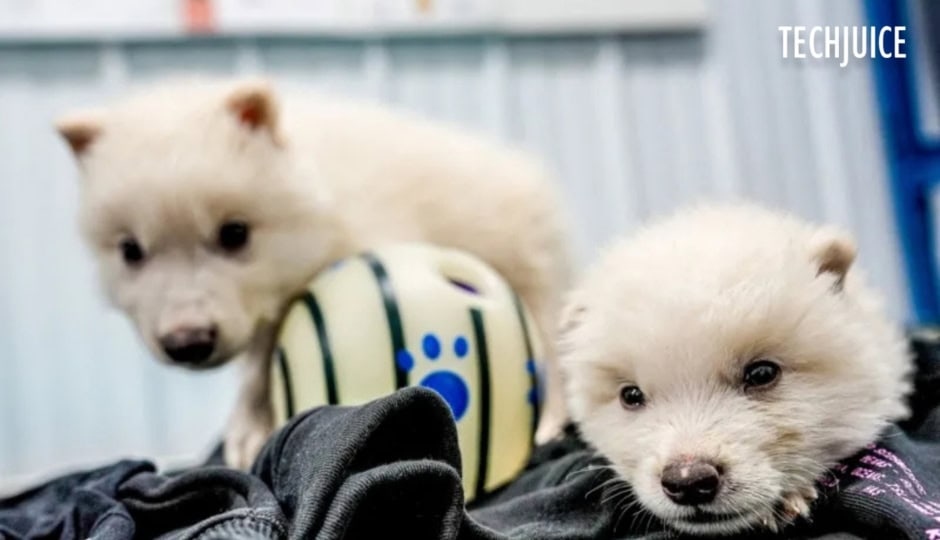Extinct No More? Genetic Startup Brings ‘Dire Wolf’ Pups Back to Life in Groundbreaking Breakthrough

Texas-based biotech company Colossal Biosciences has announced the birth of three genetically engineered wolf pups, Romulus, Remus, and Khaleesi, who resemble the long-extinct dire wolf, marking them as the “world’s first successfully de-extinct animals.”
The announcement has sparked global excitement and controversy, with Colossal stating that the pups were born using genetically modified cells derived from ancient dire wolf DNA. The company claims this feat marks a pivotal moment in de-extinction science, an emerging field focused on reviving extinct species to restore ecological balance.
“With the birth of Romulus and Remus, de-extinction is no longer a theory—it’s reality,” Colossal said in an official statement.
A pair of pups delivered by cesarean section on October 1, 2024, and January 30, 2025, employed ancient DNA processing alongside CRISPR gene editing and synthetic biology techniques. Scientific teams took DNA from dire wolf fossils that dated over 72,000 years before introducing genetic markers into current grey wolf embryo cells. These embryos were implanted in surrogate domestic dogs, leading to the historic births.
During the Ice Age, Aenocyon dirus wolves, popularly known as dire wolves, had their natural habitat in both North and South America. These predators hunted huge mammals like bison and horses. The physical build of dire wolves differed significantly from that of modern wolves, as they had broad skulls, sturdier legs, and greater body sizes, making them excellent predators.
While the wolves in HBO’s Game of Thrones helped popularize the species in pop culture, real dire wolves went extinct over 10,000 years ago, likely due to climate change and competition for prey.
“Many people view dire wolves as mythical creatures,” said Game of Thrones author George R.R. Martin, who is also an investor and cultural advisor at Colossal. “But in reality, they have a rich history in the American ecosystem.”
Are Dire Wolves Making a Comeback?
Despite the enthusiasm, the announcement has stirred debate among scientists. Some experts argue that while the pups exhibit dire wolf-like traits—including larger size, white coats, and broader heads—they are genetically closer to grey wolves than true dire wolves.
“These are genetically modified grey wolves,” said Dr. Nic Rawlence, paleogeneticist at the University of Otago. “Ancient DNA is too damaged to fully recreate an extinct animal. What we’re seeing is a hybrid, not a clone.”
Colossal Biosciences acknowledges the controversy but maintains that their approach represents a new form of functional de-extinction, one that replicates extinct traits even if the full genome isn’t restored.
“It carries dire wolf genes and looks more like a dire wolf than anything seen in 13,000 years,” said Love Dalen, evolutionary genomics expert and advisor to Colossal. “That’s very cool.”
What’s Next for De-Extinction?
Colossal is not stopping at dire wolves. The company, currently valued at over $10.2 billion, has also announced plans to revive other extinct species, including the woolly mammoth, Tasmanian tiger, and the dodo.
With $435 million in funding and a dedicated 2,000-acre private facility in the northern United States to house the animals, the company says its long-term mission is to use genetic technology to aid biodiversity conservation and ecosystem restoration.
However, conservationists urge caution. “Extinction must remain a serious lesson,” said Dr. Rawlence. “If we start believing we can just bring back species, we risk ignoring the urgency of protecting what we already have.”
While some scientists debate whether these pups are true dire wolves or advanced hybrids, the achievement by Colossal Biosciences is being hailed as a turning point in de-extinction science. The company plans to continue its work with other extinct animals, including the woolly mammoth and the dodo.
Sharing clear, practical insights on tech, lifestyle, and business. Always curious and eager to connect with readers.


 3 min read
3 min read
















